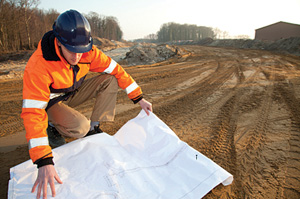The Deep Foundations Institute (DFI) announced that the keynote address at this year’s 38th annual Conference in Phoenix will be given by Jerry A. DiMaggio. The veteran civil engineer and principal at Jerry A. DiMaggio Consulting LLC is a retired principal bridge engineer and national geotechnical program manager with the U.S. Federal Highway Administration in Washington, D.C. He has consulted on more than 1,000 civil projects throughout the United States and the Americas, as well as the Middle East and Australia. DiMaggio also has a list of honors and awards that includes: U.S. Department of Transportation Administrator’s Award, the International Geosynthetics Society Achievement Medal and FHWA’s Engineer of the Year. He also served on the American Society of Civil Engineers’ Geo-Institute National Board of Governors and is a member of the Academy for Geotechnical Professionals.

|
| Jerry A. DiMaggio |
He is also an adjunct professor at several universities. For the last few years, he has been conducting various forms of training, including webinars. The keynote address will discuss facts and fiction associated with Load Resistance Factor Design (LRFD), as well as outline advantages and limitations of that standard. DiMaggio is passionate about spreading the message of LRFD and implementing this standard among the old and the new generation of the geo-engineering and geo-construction communities.
Q. Can you give a brief summary and history of Load Resistance Factor Design? Where did it come from and what problem does it solve?
A. That’s a brief question but a long answer. So, LRFD was originally developed as a design platform for the transportation industry in the late 1980s and the first national specification was published in 1994. It’s a comprehensive design guide that addresses all aspects of design and construction, including structural foundations, for the surface transportation industry.
Q. How many states are fully implementing the LRFD standard? In 2005, 16 states had it so has it increased?
A. No, it’s not 16. As of 2008, if there is any federal money involved with the new projects their design and construction must be done using a Load Resistance Factor Design platform. So, theoretically, all 52 agencies including the District of Columbia and Puerto Rico have to be using LRFD design principles for their projects
Q. What is the status of implementation for federally funded projects for LRFD?
A. Well, all the states are using it in some fashion. I believe there is a lot of communication and clarification that still has to occur as the states and their consultants begin to translate their process from the traditional design platform to an LRFD design platform. So, as I said before, theoretically they are all doing it. But how they are doing? And are they doing it correctly? And are they completely understanding and comfortable with the process? Probably very few states would fall into that category.
Q. What do you think is the main challenge with the whole process?
A. I think there are a couple of issues that are causing the delay in acceptance and utilization of LRFD on a routine basis. One is that, in the university system in the United States, there are very few courses that are related to geotechnical and foundation engineering that are taught in an LRFD platform. So, the younger engineers who are graduating are still being taught in a traditional allowable stress platform. The other reason largely is, traditionally, the design of foundations was done without much codification or standardization of practice. Some individuals therefore believe that the LRFD specifications constrain and restrict the engineering judgment of people, which is imperative for the design and construction of geo-features. I don’t think that is a correct perception. And the final reason is, maybe a complete or partial misunderstanding of the specification requirements and the commentary of the code, which clearly allow and encourage the integration of local practice.

|
| DFI keynote speaker Jerry A. DiMaggio says the best way to understand LRFD as a design platform is to apply it in practice. |
Q. How does that misunderstanding happen?
A. I believe it’s at the educational level and the difficulty is, this is something radically new for many people and I think there really hasn’t been a large amount of practical training at a local level. The training, specifically, is perhaps twofold. One is the education in terms of meeting the intent of the specification. The second, and probably the more significant impediment, is the agencies and their consultants already are designing foundations, so it becomes a translation of what they are doing now and how do they integrate or adopt LRFD into their existing practice. Since each agency’s practice is somewhat unique, so then must the translation be unique.
Q. Are they willing to change and transition?
A. Human nature is such that we don’t like change. In particular, engineers are perhaps more conservative and apprehensive to change than other people because of their significant concern, which is legitimate, to risk associated with something that is new. So, is there a willingness to change? I would say yes. I think it’s just embodied in human nature and in how engineers are trained.
Q. So, you think that makes the process slower?
A. It does make the process slower. Certainly, the process could be expedited. But it will take time and significant resources, and it has to be done at a local level, working with people on particular projects involving numbers and decisions can demonstrate how the code is applied. I also want to add, an often asked question is “Why do we focus on AASHTO (American Association of State Highway and Transportation Officials) when discussing the LRFD, and is the AASHTO code applicable to government-funded projects in other civil engineering sectors as well as other non-government funded projects (private sector projects). The answer is, we focus on AASHTO because it is currently the most comprehensive guide in the United States, in my opinion, and it is maintained on an annual basis. And it could be applicable with some modification to high-speed rail projects, energy projects and even to the private sector that might be controlled by codes and standards, such as the International Building Code. It may be attractive, in some cases, for those projects; it’s not a mandate, as it is for the highway industry. It may be attractive, in a sense, if it results in a safer, and in some cases, a more efficient and a lower risk project.
Q. Do you have an idea of current federal plans to reach full implementation of LRFD?
A. There are on-going training courses by the Federal Highway Administration; their client is the highway community, but they have limited resources so I think the private sector and the professional community are really the ones that have to help advance practice. I am biased toward LRFD for several reasons, one being that it can help the foundations and the construction communities in the specialty areas of structural foundations and earth retaining structures. Full acceptance and implementation of LRFD will require more than an educational and implementation deployment program led by federal agencies. These federal efforts should be complemented by other individuals, educational institutions and professional associations [like the] DFI (Deep Foundations Institute), PDCA (Pile Driving Contractors Association), ASCE (American Society of Civil Engineers), etc.
Q. In your experience as a teacher, how are you spreading the message on LRFD?
A. I do a number of live delivery and a number of webinars on LRFD on different topics related to foundations and geotechnical engineering. The ASCE webinar series has being going on for five years and we still get a pretty good attendance. I think the message is that, LRFD is the design platform of the future. It is very good for the overall community. Among the many benefits is it fosters a better relationship between the structural, construction and the geotechnical communities.
The concept is: LRFD is not something to be afraid of. It’s something to provide you with an edge, whether you are a contractor or a designer, because this is the way things will be done from here on out. While it is not mandated by other industries or other codes, there will come a time when that’s the way you will design and monitor projects. I mentioned the university system before, and currently geotechnical design and foundation design is not generally taught in LRFD, but every single structural design and analysis class is taught in LRFD. So a disadvantage is that, if the structural engineers understand LRFD and if the geotechnical specialists speak a different language, it creates a communication obstacle.
Q. How do you think the education process has helped in the last few years? Are the universities more open to including the LRFD format for the geotechnical engineers?
A. I think the process is slow. I really don’t have a means of assessing. I have become more aware that gradually more universities are embracing LRFD within the geotechnical courses. I know of one commonly used textbook for foundation and geotechnical design, which is currently being updated and rewritten in an LRFD format. I understand it will be published in 2014. To my knowledge, that will be the first textbook that has that focused on LRFD or the geotechnical features.
Q. What are some common misconceptions about transitioning into LRFD codes?
A. There is a fair amount of miscommunication regarding LRFD, which results in people misjudging its benefits and limitations. The only way to really understand and embrace this design platform is to apply it to a particular project and to carefully and critically examine the results. I would readily admit that the current AASHTO code is not perfect. The code represents a substantial change for the geotechnical engineering and construction communities, as compared with traditional practice. It’s natural to expect that refinements will be ongoing for a while, but clearly this change should not be feared if applied in an informed and prudent manner. In fact, I would predict that people who don’t apply it will be disappointed and left behind in the future.






Report Abusive Comment